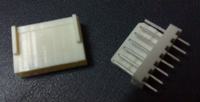
- Joined
- Jul 4, 2009
- Messages
- 16,411
- Helped
- 5,153
- Reputation
- 10,335
- Reaction score
- 5,177
- Trophy points
- 1,393
- Location
- Aberdyfi, West Wales, UK
- Activity points
- 138,858
It's nice to see someone else with schematics on paper all over the desk - it stops me feeling I'm the most untidy person in the World 
I think the point you are making is that the current changes path depending on it being in current limit or under microprocessor control. That isn't exactly true but you are on the right lines. The thing to remember is the 338 is an adjustable regulator and the output voltage it produces is set by the voltage on the 'Adj' pin.
Now imagine Q1, Q2 and Q3 do not exist, the only components to set the output voltage are the resistors. The 0.1 Ohm resistor is so small it plays almost no part in setting the voltage so ignore it, the other two resistors are a potential divider, they DO set the output voltage. The purpose of the transistors is to lower the voltage on the 'Adj' pin so the output voltage also decreases, so if all transistors are NOT conducting, only the resistors set the output. For this reason, the resistors are chosen to produce a voltage just a little higher than you actually need.
If Q1 or Q2 conduct, their collector voltages will drop to almost zero and the variable resistors will be in parallel with the 2.4K resistor, reducing it's effective value and dropping the 'Adj' voltage and hence the output voltage. You have control of Q1 and Q2 as they are switched on or off by the microprocessor.
Q3 does exactly the same as Q1 and Q2, it drops the 'Adj' pin voltage if it conducts. The difference is that something else switches it on. That something is the voltage dropped across the 0.1 Ohm resistor. Remember that the transistor will not start to conduct until the voltage between its base and emitter pins reaches about 0.6V and that those pins are connected across the 0.1 Ohm resistor. This means that at 6A, the voltage across the resistor will be 0.6V and the transistor will conduct and pull the output voltage down. It reaches an equilibrium when the reduced voltage, and therefore reduced output current, starts to turn the transistor off again.
To reduce the current at which it starts to limit, Q3 has to conduct sooner so to make it limit at say 3A, the 0.1 Ohm resistor has to be made larger as Pauloynski
explains.
Brian.
I think the point you are making is that the current changes path depending on it being in current limit or under microprocessor control. That isn't exactly true but you are on the right lines. The thing to remember is the 338 is an adjustable regulator and the output voltage it produces is set by the voltage on the 'Adj' pin.
Now imagine Q1, Q2 and Q3 do not exist, the only components to set the output voltage are the resistors. The 0.1 Ohm resistor is so small it plays almost no part in setting the voltage so ignore it, the other two resistors are a potential divider, they DO set the output voltage. The purpose of the transistors is to lower the voltage on the 'Adj' pin so the output voltage also decreases, so if all transistors are NOT conducting, only the resistors set the output. For this reason, the resistors are chosen to produce a voltage just a little higher than you actually need.
If Q1 or Q2 conduct, their collector voltages will drop to almost zero and the variable resistors will be in parallel with the 2.4K resistor, reducing it's effective value and dropping the 'Adj' voltage and hence the output voltage. You have control of Q1 and Q2 as they are switched on or off by the microprocessor.
Q3 does exactly the same as Q1 and Q2, it drops the 'Adj' pin voltage if it conducts. The difference is that something else switches it on. That something is the voltage dropped across the 0.1 Ohm resistor. Remember that the transistor will not start to conduct until the voltage between its base and emitter pins reaches about 0.6V and that those pins are connected across the 0.1 Ohm resistor. This means that at 6A, the voltage across the resistor will be 0.6V and the transistor will conduct and pull the output voltage down. It reaches an equilibrium when the reduced voltage, and therefore reduced output current, starts to turn the transistor off again.
To reduce the current at which it starts to limit, Q3 has to conduct sooner so to make it limit at say 3A, the 0.1 Ohm resistor has to be made larger as Pauloynski
explains.
Brian.


